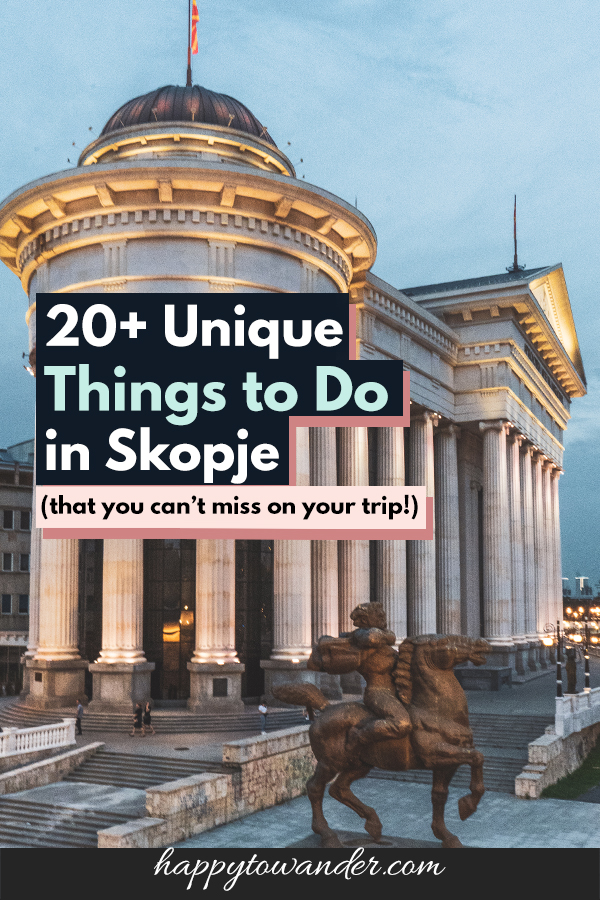*FYI - this post may contain affiliate links, which means we earn a commission at no extra cost to you if you purchase from them. Also, as an Amazon Associate I earn from qualifying purchases. Check out our Privacy Policy and Disclosure. for more info.
Kitschy, puzzling and shamelessly grand, the North Macedonian capital of Skopje (AKA Balkan Las Vegas) is a destination that truly divides people.
At first glance, Skopje has all the trappings of a grand European capital – a gleaming central square (with a ‘hero on horse’ statue), buzzy riverside bars, epic Neoclassical buildings and fountains, bridges, and museums all over.
… but take a closer look, and not a lot of things in Skopje make sense. Those neoclassical edifices for instance? Built in the 2010s. There’s also fake old timey ships docked on the river, red double decker buses zooming around town, and statues. A truly frightening amount of statues… seemingly perched on every street corner.
Skopje is certainly not one of my favourite cities in Europe, but I’ll concede that it’s intriguing, and aesthetically, actually quite pretty… although at a steep cost that some say went hundreds of millions over budget (read up on Skopje 2014 if you want a wild ride).
But whether you love it or hate it, whether you react with fascination or anger, the inevitable thing is Skopje will leave an impression (and expand your waistline with its endless parade of food, drink & börek).
So, if you’re keen to explore for yourself, here are some of the best things to do in Skopje, from statuesque sightseeing and pirate ship hotels to museums and markets spanning (what looks like, at least) centuries of history.
1. See all the statues
Alright – let’s start with a big one.
One of the most striking things any visitor will notice about Skopje is that there are statues…. everywhere, commemorating things ranging in importance from prominent Macedonian figures to… random, unnamed women in sunglasses shopping.
Why so many statues? Well, as I alluded to in the introduction, many of the modern, glamorous additions to Skopje were part of a beautification campaign called “Skopje 2014”, an initiative by the government to build all sorts of massive monuments, fountains, statues and more around the city center to increase tourism.
It was a costly project, and one that continues to divide/wow both visitors and residents alike. But one thing remains clear: there are now over a hundred statues around the city center, of every possible thing you can imagine.
I can’t possibly list out all the statues for you to see, so I’ll simply say this: just keep your eyes open and you’ll see dozens within minutes. Don’t forget to photograph your favourites!

Here’s one of mine:
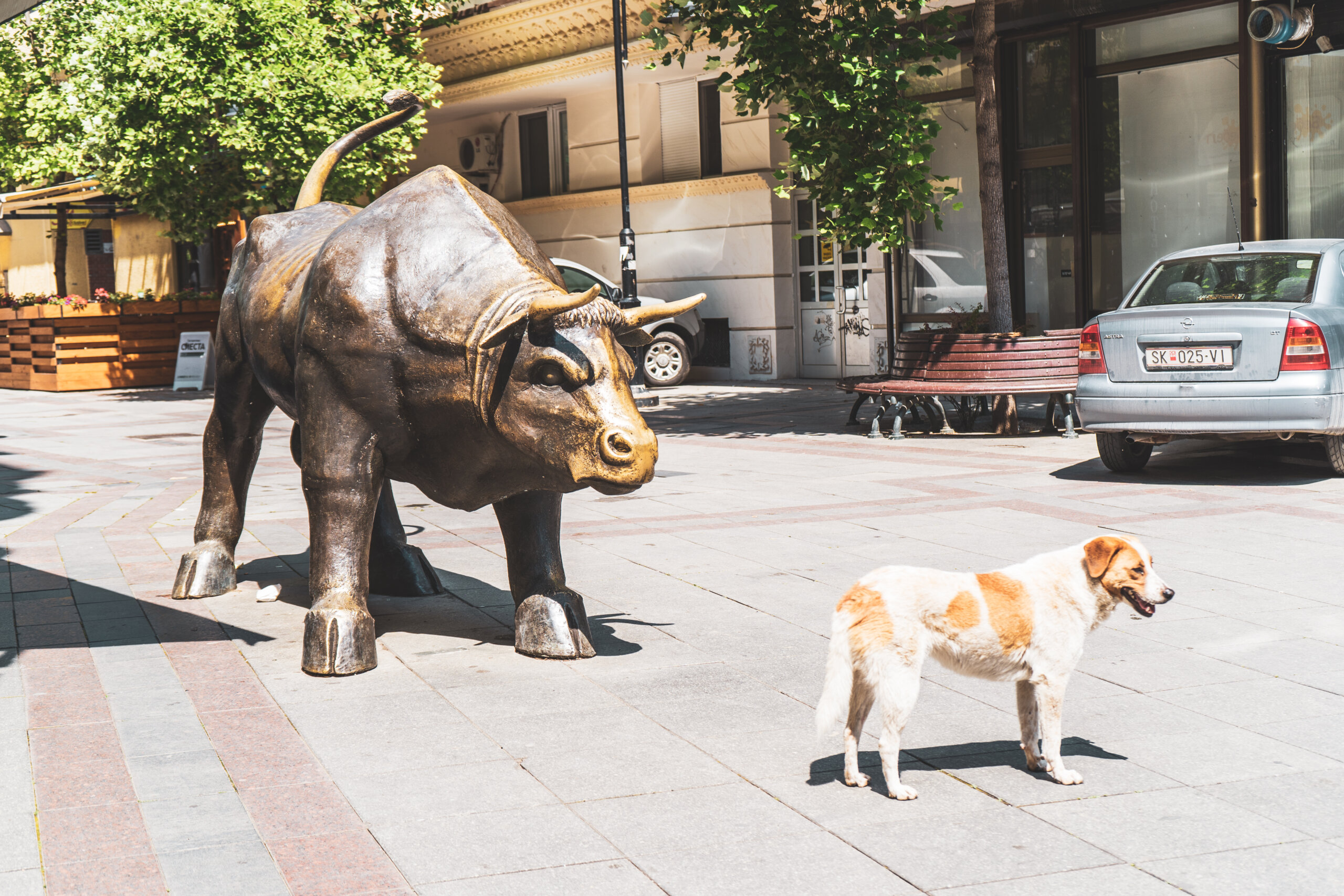
2. Admire the strange mish mash of architecture
As previously mentioned, when you start to look at it more closely, many things in Skopje don’t make sense.
But hey, it makes for some very fun walks.
A stroll through central Skopje is full of surprises – it’s at times strikingly beautiful, with grand monuments and glitzy lamps lighting up the polished pieces of its skyline, but at times jarring, once you remember the recency of these additions and their eye-gouging price tag.
But where else are you going to see brutalist concrete wonders sharing block space with Neoclassical buildings younger than Gangnam Style? Or gilded bridges guarded by million euro lions cast in Florence of all places?
(I assume nowhere else, but I’d love to be wrong)
In any case, simply walking around and ogling the strange architectural marvels of the city is one of the best things to do in Skopje.


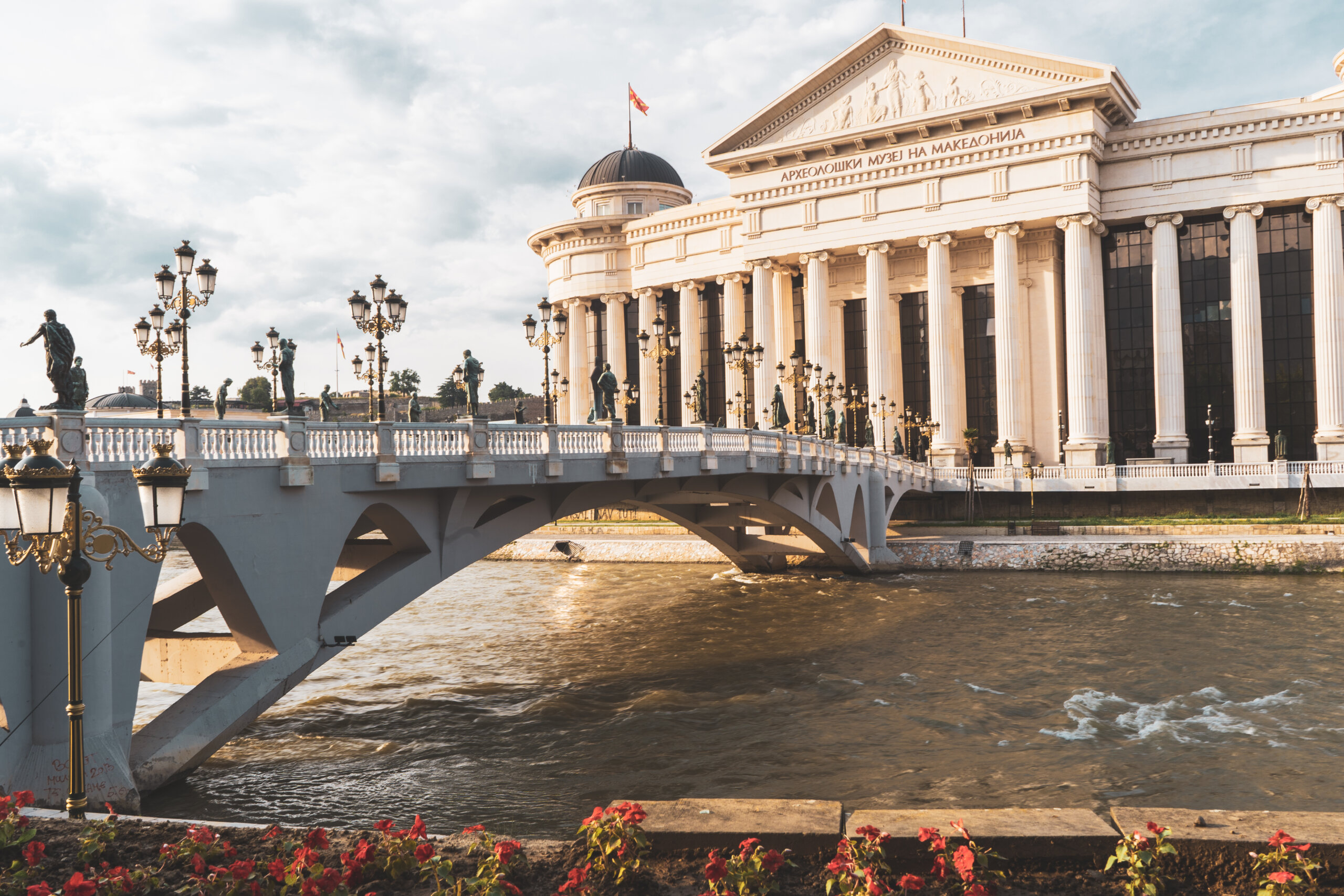
3. Visit Macedonia Square
With its giant fountain, giant Marriott, and even more giant bronze statue of Alexander the Great, there is truly nothing subtle about Macedonia Square.
But hey, if we’re embracing the kitsch of Skopje, a visit to the city’s main square is a must.
This square is actually the largest in the entire country, covering an area of of 18,500 square metres leading from the stone bridge. Often called the heart of Skopje, the ground in this square is tiled with marble in cool curling patterns and is where many events are held, particularly the Christmas festivals.
While there are some shops and restaurants lining the square, there’s not much to actually do here besides ogle more statues, unless an event is on. Still, it’s definitely a must-visit, if only to see the massive statue and fountain in the centre.
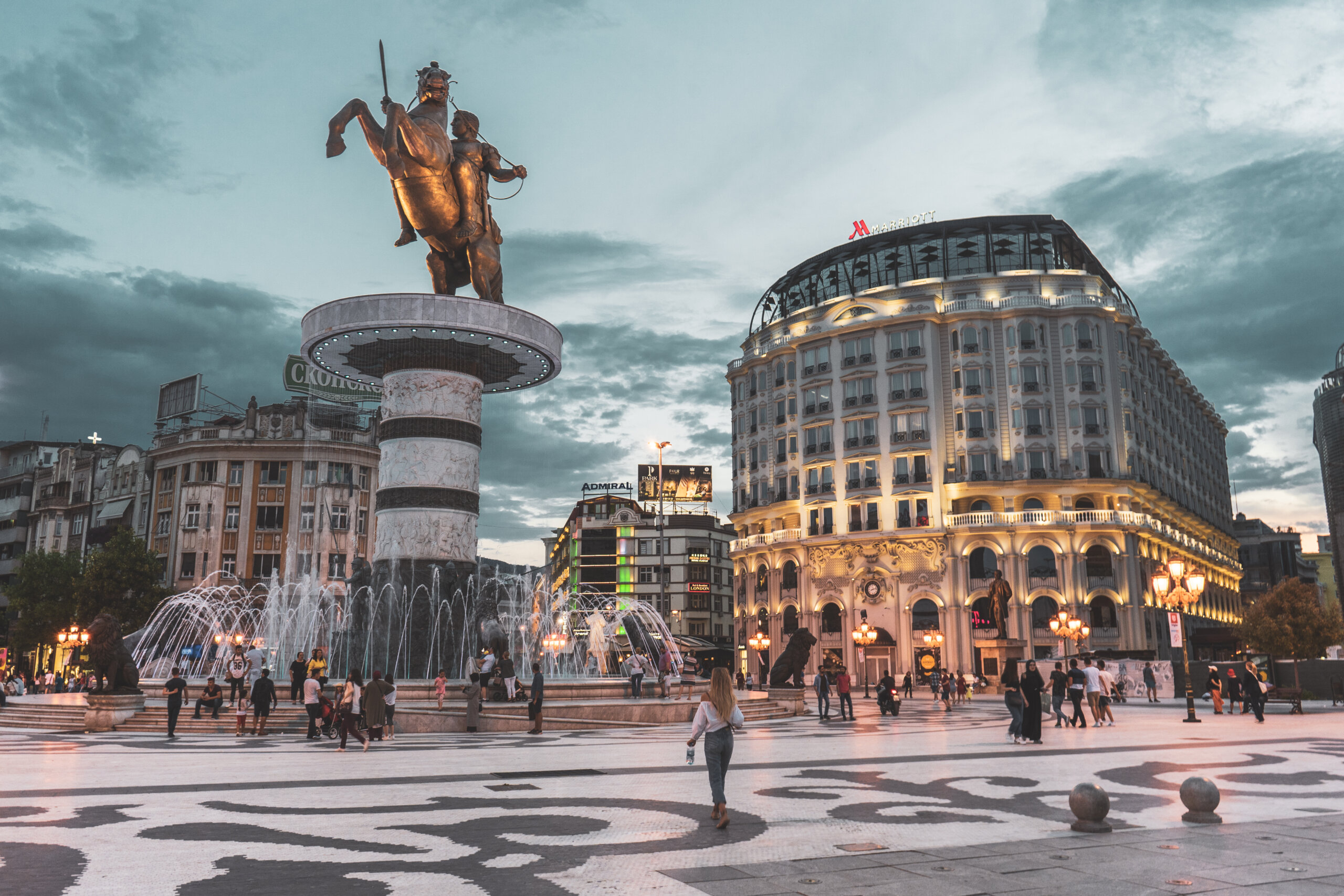
4. Old Bazaar (Čaršija)
Need a breather from all the grandiose weirdness? For a more authentic time warp (and instant aesthetic whiplash), be sure to visit Skopje’s Old Bazaar, one of the largest of its kind in the Balkans.
Here, you can explore cobblestone streets lined with Ottoman-era buildings, artisan shops, and bustling markets. This is one of the best parts of the city to shop for souvenirs or gifts, but it’s also just a great spot for soaking up the atmosphere or getting a meal. There are also multiple mosques, churches, museums and a clocktower to explore.
Architecture buffs will probably also love seeing the mix of Ottoman and Byzantine architecture, muddled along with more modern constructions.
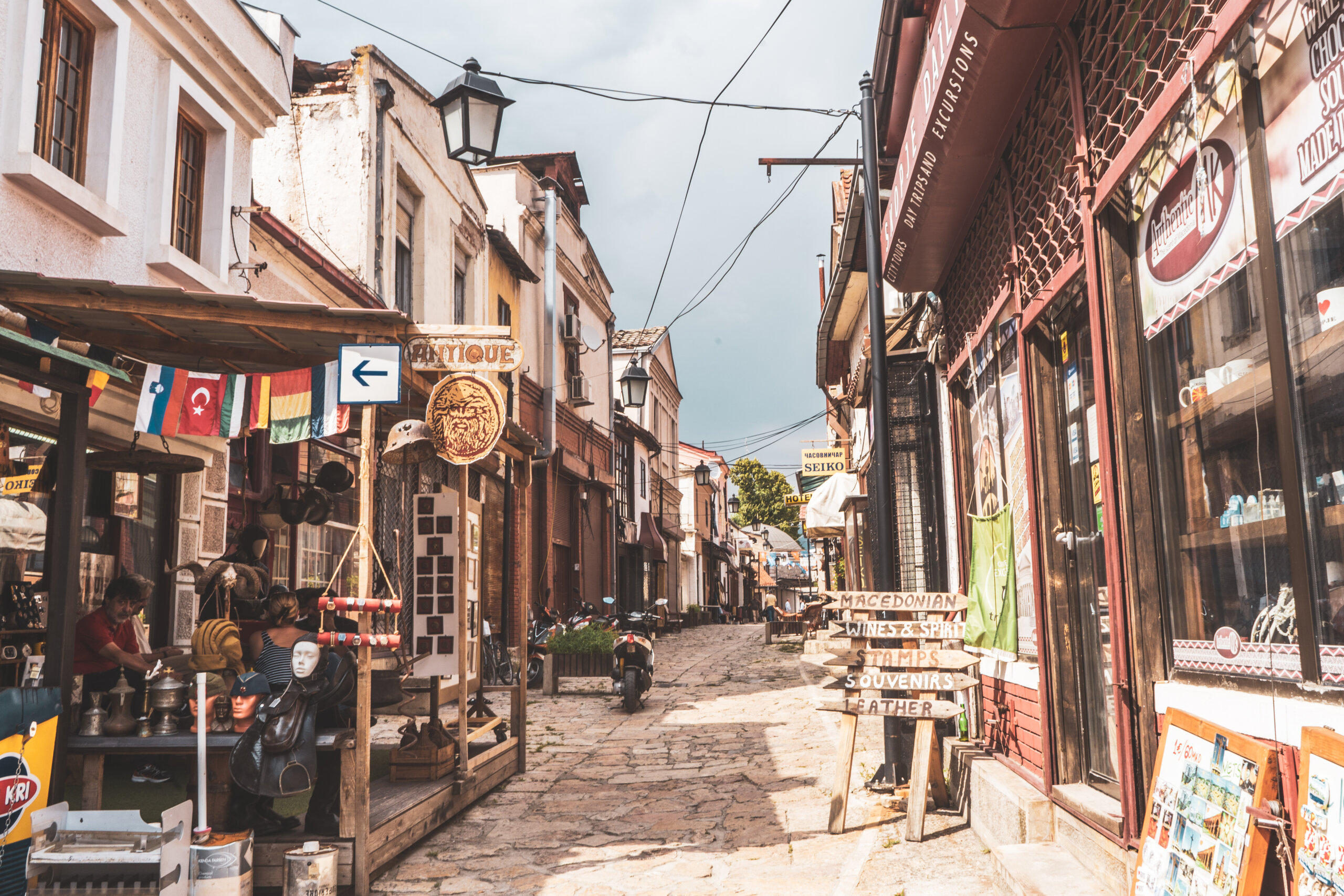
5. Kale Fortress
Another fun thing to do in Skopje is a visit to Kale Fortress, which offers some of the best views in town.
This fortress is perched atop a hill overlooking the city and its history dates back to the 6th century. It’s believed that the Byzantine Emperor Justinian I built the first fortifications on this site, though the site has witnessed many significant events throughout history, including the rule of the Ottoman Empire, which further fortified the structure.
Today, the Skopje Fortress is a popular tourist destination, particularly for the panoramic views you can enjoy from the ancient walls and towers… and best of all, it’s free!
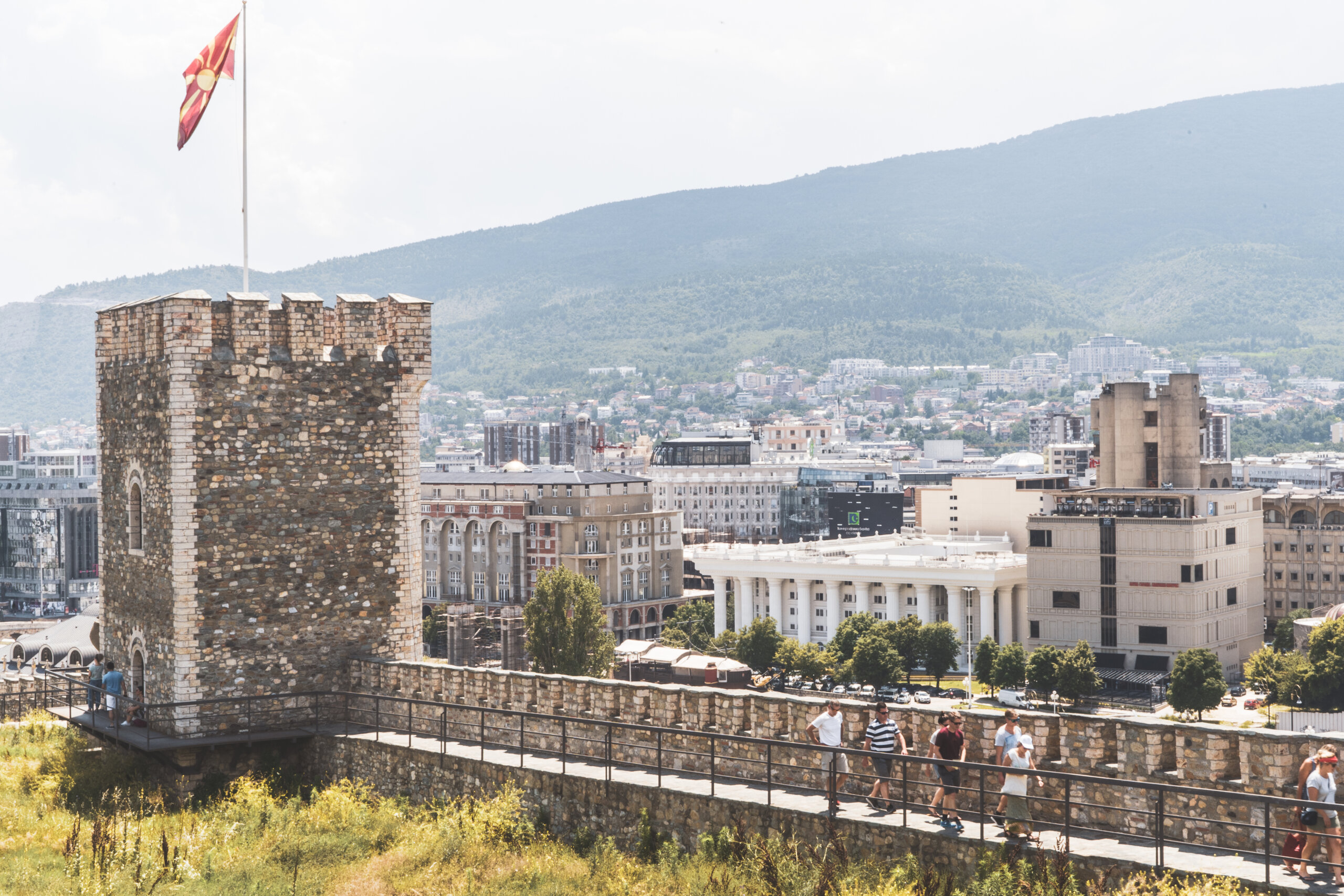
6. Stone Bridge
While we’re admiring Skopje’s oldest things, don’t forget to check out Stone Bridge, an iconic symbol of the city.
This bridge spans the Vardar River from Macedonia Square to the Old Bazaar and was built between 1451 and 1469 on top of older Roman foundations on the orders of Sultan Mehmed II the Conqueror.
Over the years, it has been damaged and repaired many, even narrowly avoiding being destroyed by the Nazis when they retreated from Skopje in November 1944 – they placed explosives on the bridge but didn’t end up detonating them.
Fun fact: the bridge is part of both the coat of arms and city flag of Skopje, along with the river, fortress and the Šar Mountains. Some people have also claimed that it represents the split between the two parts of the city: Ottoman, historic and Albanian on one side, with modern, socialist and Macedonian on the other.
In any case, it’s a pretty bridge and since it’s how you get to and from many of the main sights in Skopje, enjoy thinking about this little history lesson as you look at it or cross it!
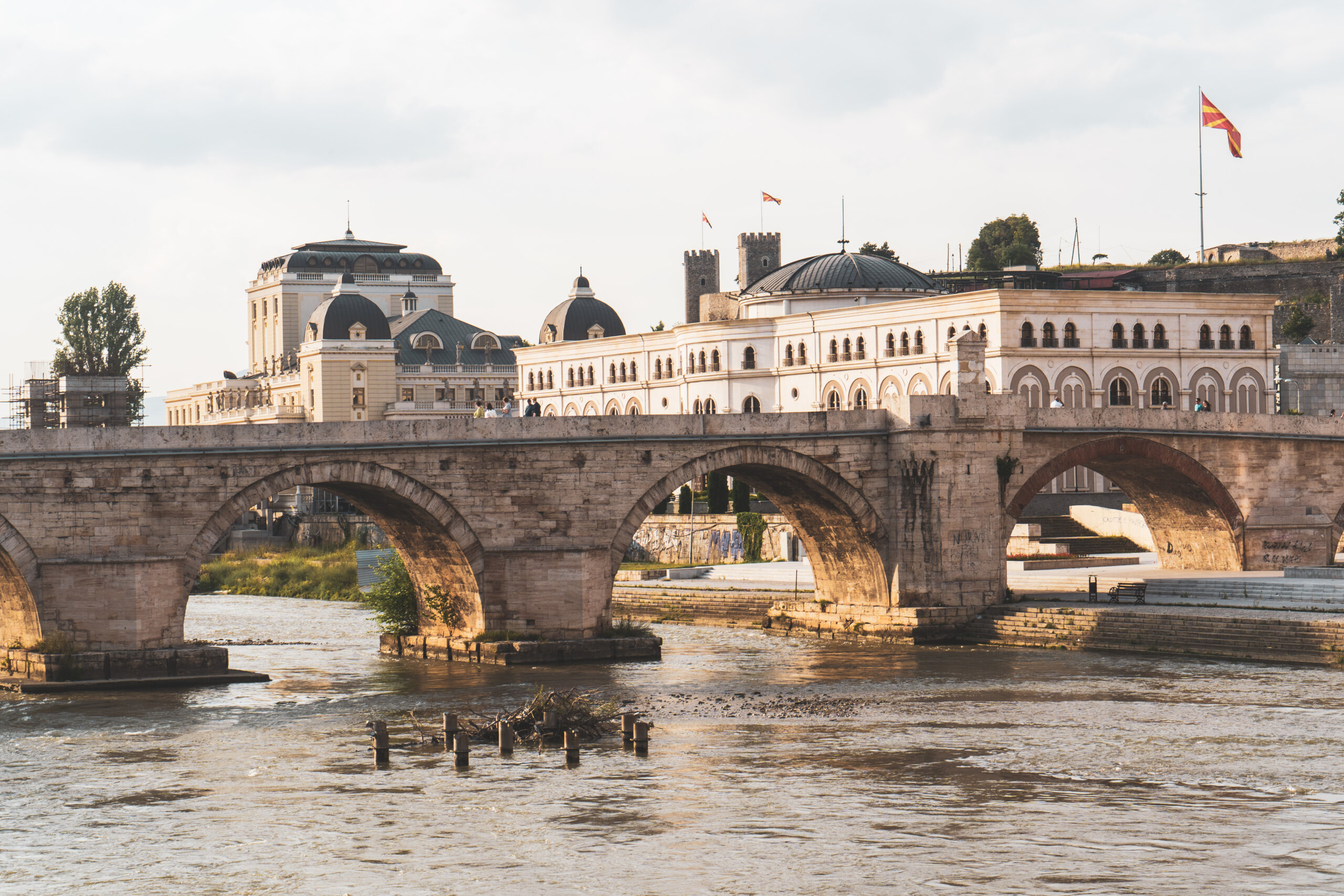
7. Admire Art Bridge
Gaudy as it might be, I do really love Skopje’s Art Bridge.
I mean, the name alone should clue you in on just how much this bridge pulls at romantic heartstrings. True to Skopje form, it’s packed with almost 30 statues of notable artists and musicians, each with their own shiny gold-wrapped lamp posts. It’s… a lot, but it’s pretty to look at, and probably one of the most photogenic spots in town.
BONUS BRIDGE: In between the Art Bridge and the Stone Bridge, there’s another bridge also packed with statues – the Bridge of Civilizations, which features statues of political/thought leaders rather than artists.

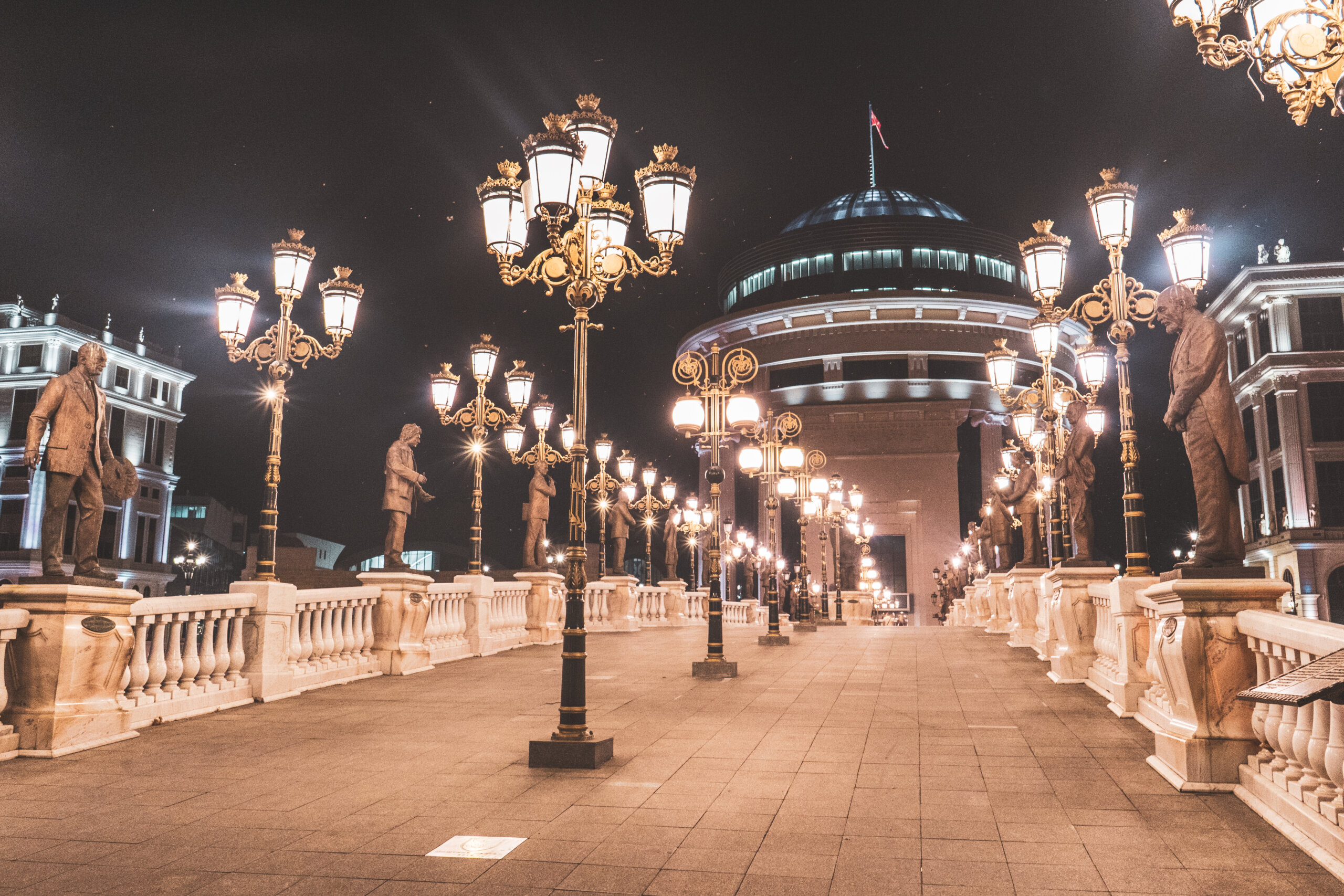
8. Visit the Archaeological Museum of the Republic of North Macedonia
At one end of the Bridge of Civilizations, you’ll find the Archaeological Museum of the Republic of North Macedonia, housed in a stunningly grand neo-classical style building.
Inside are collections of archaeological artefacts from all over North Macedonia including pottery, jewellery, and sculptures. While the displays look great, they are still working on English informational texts though, so if you don’t understand Cyrillic (or have someone who does with you) then you may not get the whole story about many of the items on display.
But if you are really into archaeology then you will probably still find it a fun destination, especially as the basic adult ticket costs 150 denars or about €2.50.
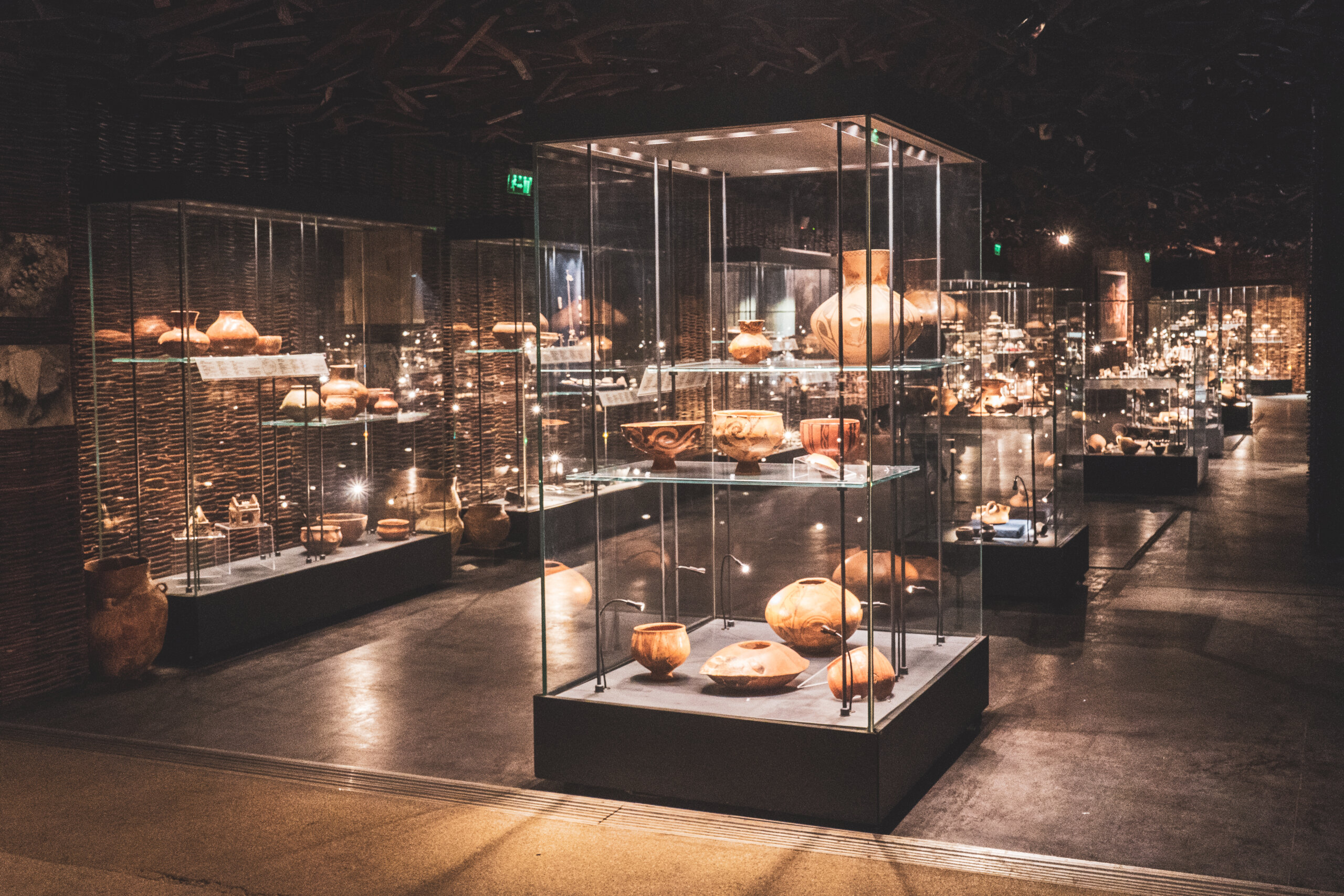
9. Mother Teresa Memorial House
Alright, ready for another Skopje surprise? Well, fun fact: (controversial) humanitarian Mother Teresa was born here in Skopje, and they have a memorial house dedicated to her on the site where she was baptized.
This house (like many things in Skopje) has been considered pretty controversial – not only does the design of it stick out like a sore thumb, it also has little to do with Mother Teresa herself, and cost millions of euros to build.
Nonetheless, a visit here is one of the most popular things to do in Skopje. Inside, you’ll find rooms set up to tell the story of her life, with photos and a few items that she supposedly used. It’s mostly showing how she probably would have lived during her years in Skopje and is more of a symbolic museum than one displaying lots of authentic artefacts.
There’s also a small chapel in the building and a gift shop, plus it’s free to visit so if you’re in the area and interested in Mother Teresa, why not check it out?
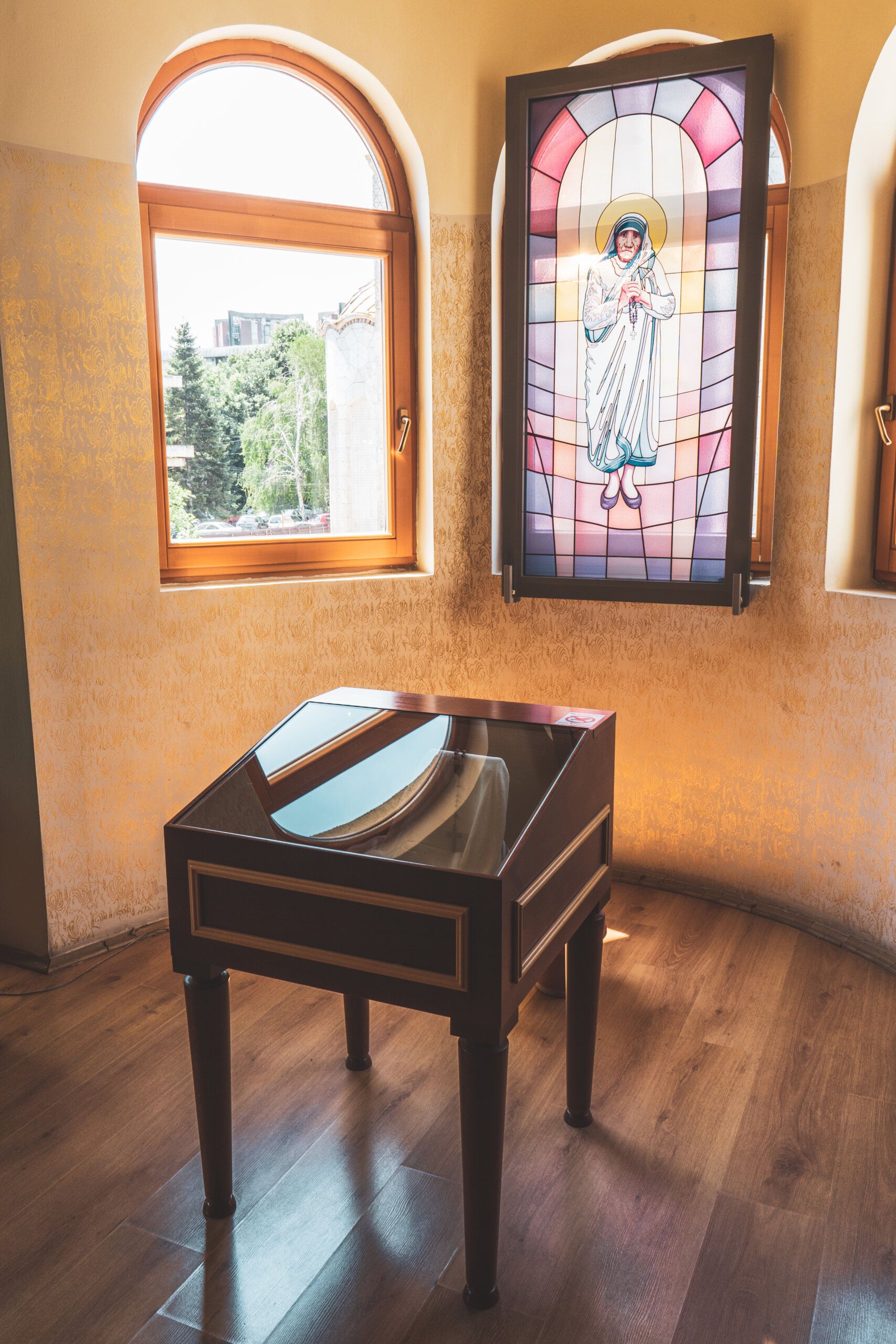
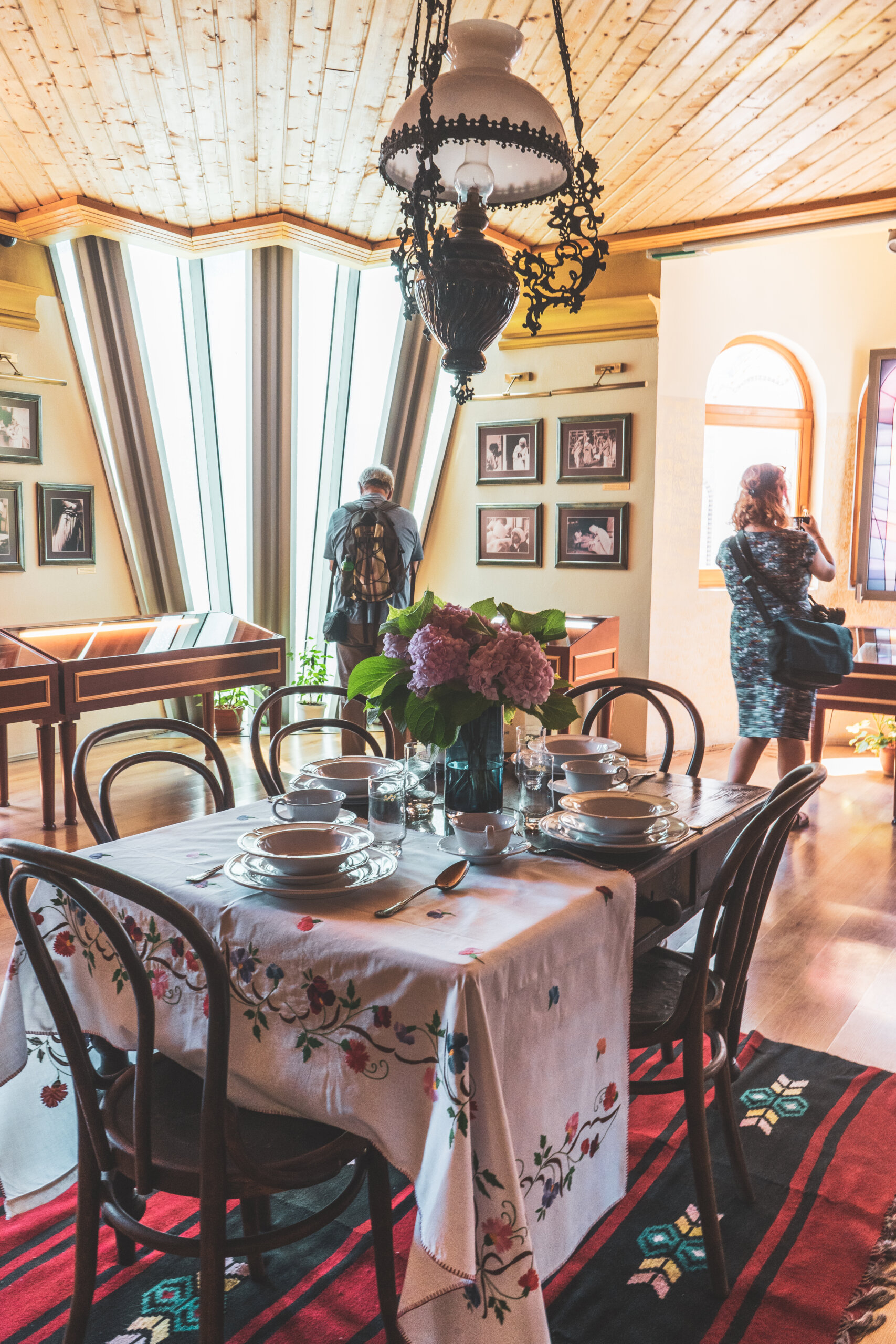
10. Museum of the City of Skopje
One of the most unique museums in Skopje is the one that’s simply called Museum of the City of Skopje, but is actually more of a museum about the 1963 earthquake.
Housed in what was originally a railway station built by the Ottomans in 1949, you can still see the damage that was done to the building on July 26, 1963 when a magnitude 6.1 earthquake hit Skopje at 5:17am. The clock on the front of the building is still frozen showing that time.
Inside the main exhibit is about this devastating earthquake, which destroyed about 80 percent of the city and killed more than 1,070 people. Other displays focus on archaeology, ethnology, history of art and modern art. It’s not huge but it’s free to visit and quite interesting, especially as parts of it are still kind of in ruins.
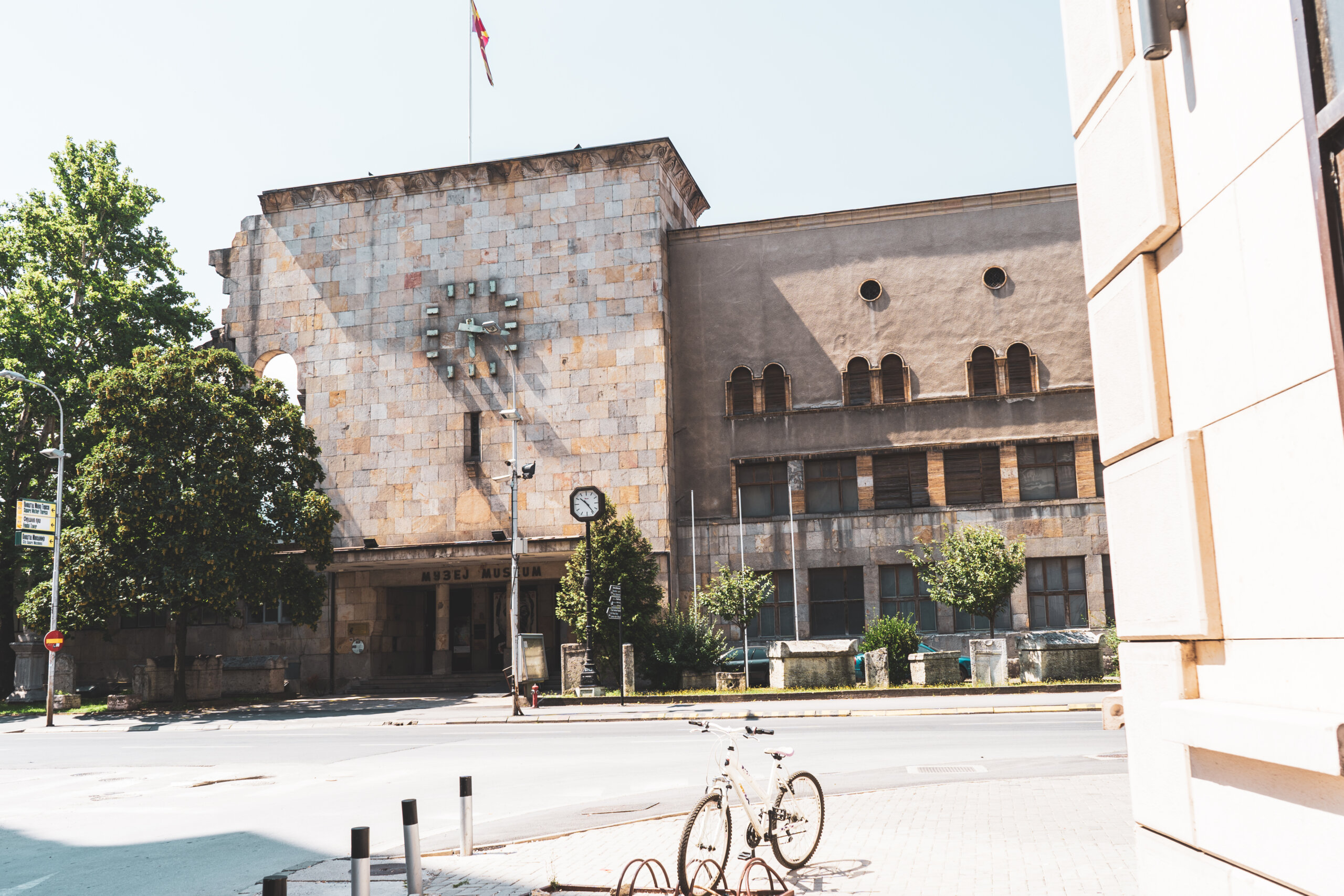
11. Museum of the Macedonian Struggle
And if you want to learn more about the modern history of North Macedonia then you can’t go past the Museum of the Macedonian Struggle for Independence (usually shortened to just Museum of the Macedonian Struggle).
This museum looks at the history of how the Macedonian peoples have struggled for independence since the Ottoman era, through the Balkan Wars, World Wars and communist Yugoslavia, before becoming an independent republic in 1991.
Opened in 2011 for the 20th anniversary of this declaration of independence, it is now one of the most-visited cultural institutions in the country.

12. Museum of Contemporary Art
Looking for cultural things to do in Skopje? Art enthusiasts shouldn’t miss the Museum of Contemporary Art, home to a collection of modern artwork from around the world.
This museum is divided into two main sections, one with international art and one with national art, although it isn’t honestly a huge museum. Sometimes there are temporary exhibitions but there isn’t much by way of a café, gift shop or even public toilets. However, it is worth a visit if only for the views, as it’s located a bit further up the hill from Skopje Fortress, with nice views over the rest of the city.
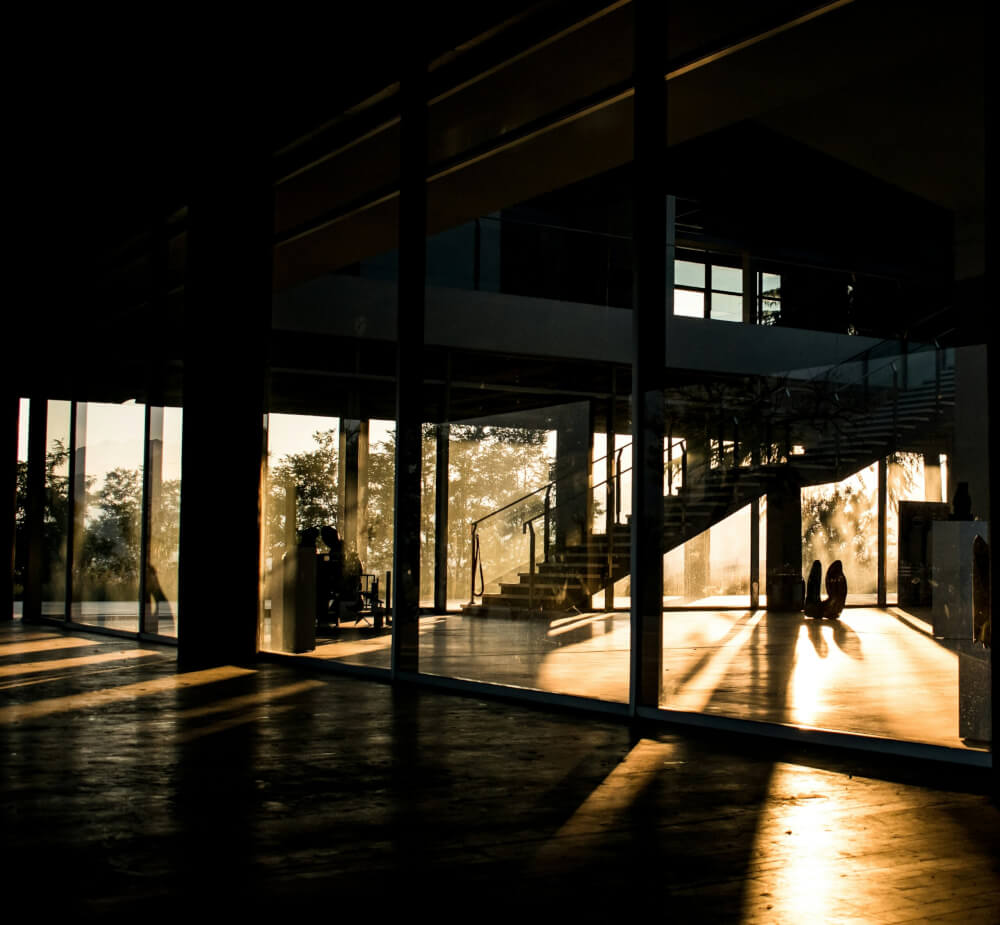
13. Mustafa Pasha Mosque
Another main sight to see in Skopje? The Mustafa Pasha Mosque.
This elegant Ottoman mosque is known for its intricate architecture and tranquil gardens, plus it’s one of the oldest mosques in the city, thanks to it largely being spared during the 1963 earthquake.
Located on a small hill overlooking the Old Bazaar, this mosque was constructed in 1492 by Mustafa Pasha, a high-ranking official in the Ottoman Empire. Its elegant design features a large dome, beautiful stone carvings, and a graceful minaret, all set within a peaceful courtyard that’s surrounded by rose gardens.
Inside, visitors can admire some stunning calligraphy and traditional Islamic art on the walls, so long as you pay attention to when it might be in use as it’s still an active place of worship. It’s also a perfect spot to sit and rest (particularly in the rose gardens) if you need a bit of a break from sightseeing!
14. See the Church of St. Clement of Ohrid
Another bit of impressive religious architecture in Skopje is the Church of St. Clement of Ohrid, the largest Macedonian Orthodox Church Cathedral in the world.
This eye-catching cathedral is actually quite young, as construction began in 1972 and was completed in 1990. Its unique design is comprised of a large central dome and smaller domes, or rotundas, surrounding it, with a large fountain in front of the entrance. The interior is also stunning, with huge frescoes and mosaics depicting biblical scenes and saints, along with a massive chandelier.
If you do visit, make sure you look up at the ceiling above the chandelier to see a huge painting of Jesus, which is apparently quite unique in its size! The main belfry is also located in a separate tower outside.
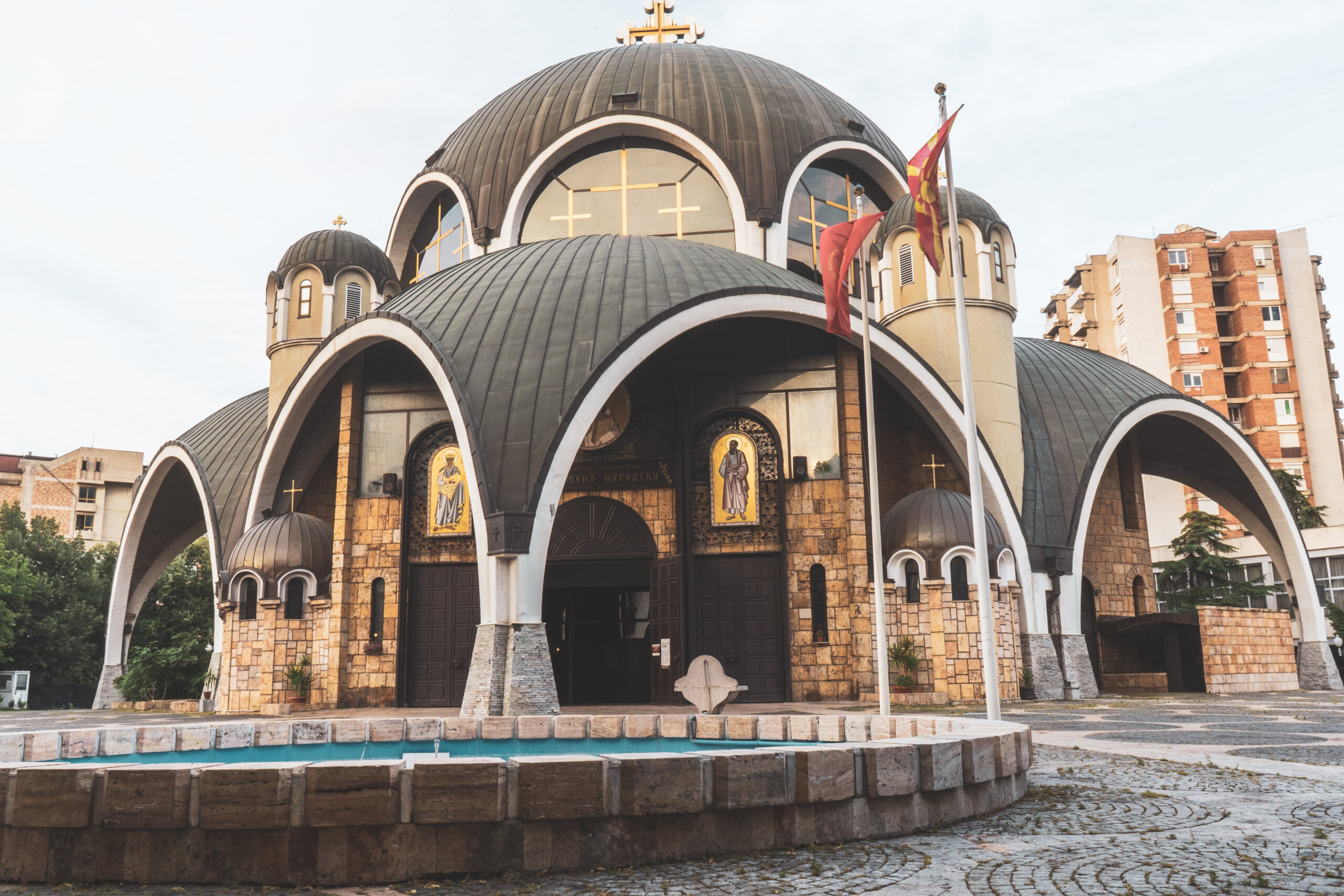
15. Millennium Cross & Vodno Mountain
If you don’t mind venturing a bit farther out, another fun thing to do in Skopje is hiking or taking a cable car to the Millennium Cross, a colossal monument atop Vodno Mountain, which provides awe-inspiring views of Skopje.
The cable car leaves from Middle Vodno, which can be reached via bus from the city centre or car if you have access to one. Then you can enjoy an 8-minute ride up the mountain with incredible views, before arriving at the summit where the Millennium Cross is located. This cross was constructed in 2002 to celebrate 2,000 years of Christianity in Macedonia, and also contains a lift inside it so you can ascend even higher.
As well as enjoying the views from the top of the mountain (and the top of the cross) there are a variety of hiking trails around Vodno Mountain, including one that will take you to the Saint Panteleimon Monastery. And if you’re feeling especially energetic, you can even ride a bike all the way to the top of the mountain.

16. Daut Pasha Hamam
Another cultural hotspot in Skopje is the Daut Pasha Hamam, a historic bathhouse that has been turned into an art gallery and cultural center.
This hamam was originally constructed in the 15th century by Daut Pasha, although it fell into disrepair before being restored in 1948 and repurposed into an art gallery that opened in 1951. Now it’s officially called the National Gallery of Macedonia Daut Pasha Hamam (yes, that’s how they spell hammam in this case) and is a great place to see Macedonian art.
The building itself is a stunning example of Ottoman architecture with its distinctive domes and elegant arches. Inside, the hamam features a series of interconnected rooms that once served as hot and cold baths, now filled with collections of traditional and modern Macedonian art, along with regular temporary exhibitions.
It’s not huge, but very atmospheric and worth a visit if you’re into art and/or architecture, especially since the entrance fee is just 1 euro!
17. Hang out in Debar Maalo
One of the coolest areas to just hang out in Skopje is the bohemian area in the city centre known as Debar Maalo.
This is one of the oldest neighbourhoods in the city, with lots of cafés, restaurants and kafanas – traditional taverns that often have live music to enjoy along with your meal. This is a very cosy area to end up at the end of the day for a meal or to get better acquainted with local life. It’s mostly a pedestrian-only zone and the vibe is just really different to other parts of the city.
NOTE: Debar Maalo isn’t actually shown on Google Maps, but Kafana Debar Maalo is and basically it’s the area around that particular restaurant, near the city park – which is also a nice spot to check out!
18. Enjoy local cuisine
When your legs and eyeballs grow tired after a day of absorbing Skopje’s kitsch, one of the best things to do is hunker down in a local restaurant to indulge in the epic comfort food that the Balkans are known for.
Knowing nothing about North Macedonian cuisine before my visit, I simply went with what sounded good on each menu I saw… and I was never steered wrong.
If you need a bit of guidance though, here are some classic dishes to put on your list…
- Tavče gravče: the national dish, which is basically beans baked with onion and paprika in an earthenware pot. Sometimes meat is included but it’s usually a vegetarian dish.
- Sarma: a traditional Ottoman dish where meat and rice (plus herbs and sauce) are wrapped in leaves or leafy vegetables. Especially nice during winter and often made for special occasions.
- Börek/Maznik: a traditional filo-like pastry which can have savoury (cheese, eggs, meat, spinach) or sweet (apple, pumpkin) fillings. Delicious served warm.
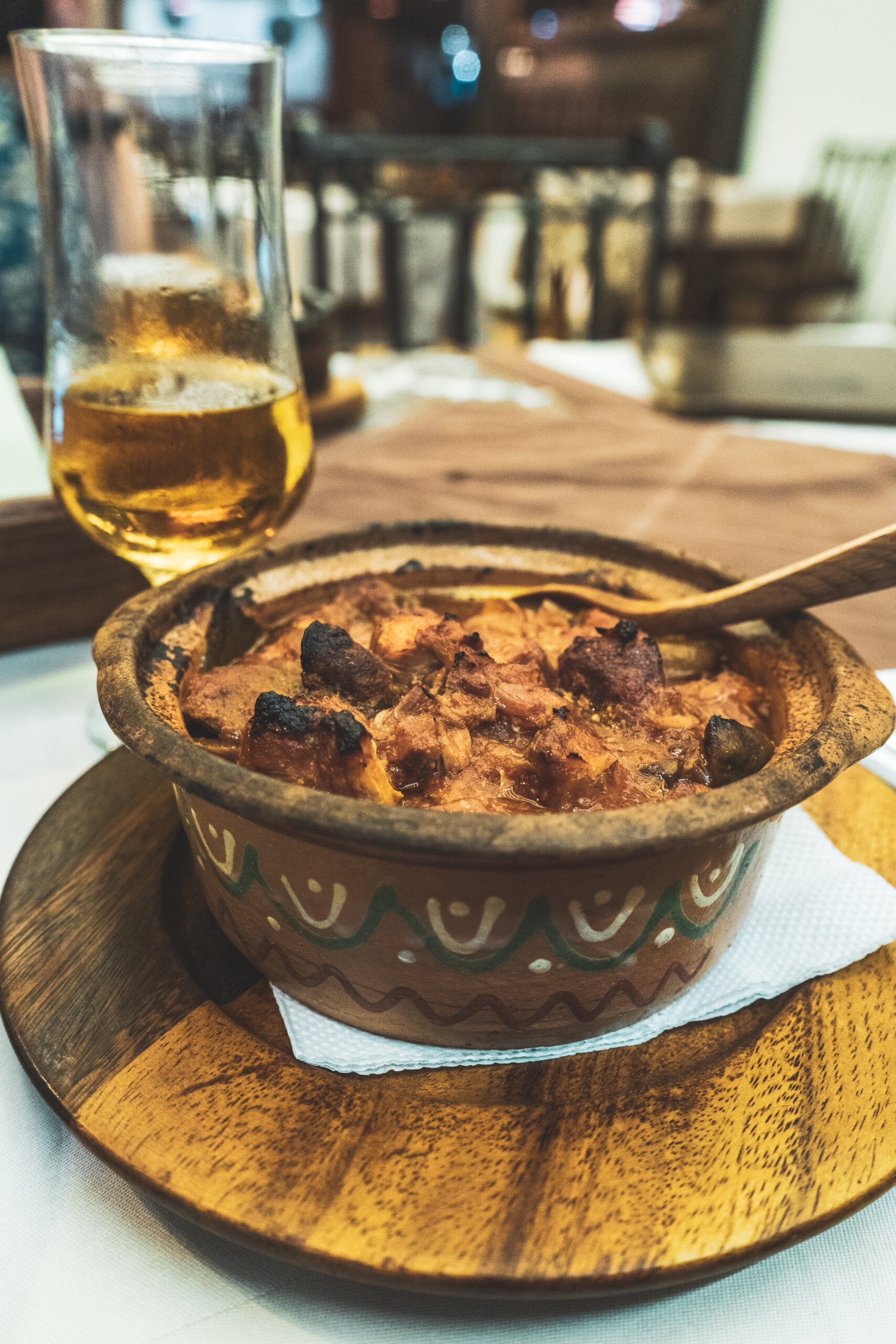
19. See the abandoned and incomplete Macedonian Orthodox church of Sts Constantine and Helena
Alright, time for another ‘only in Skopje’ type of sight.
Sadly, this is one you can only admire from afar, because it is literally not finished, and likely won’t be anytime soon.
The story of the Macedonian Orthodox church of Sts Constantine and Helena is one of many to emerge from the Skopje 2014 initiative. Long story short: when the plans for the church were initially announced, there were protests from students who didn’t want it built in a pedestrian area, leading to violent clashes between the students and the church supporters.
As a compromise, the location for the church was shifted several hundred metres, but there had also been questions about how then-Prime Minister Nikola Gruevski was funding it. Gruevski has since been sentenced to prison for corruption but sought political asylum in Hungary, while the church is now bankrupt and unfinished.
… It’s a shame too, because it does look pretty nice.
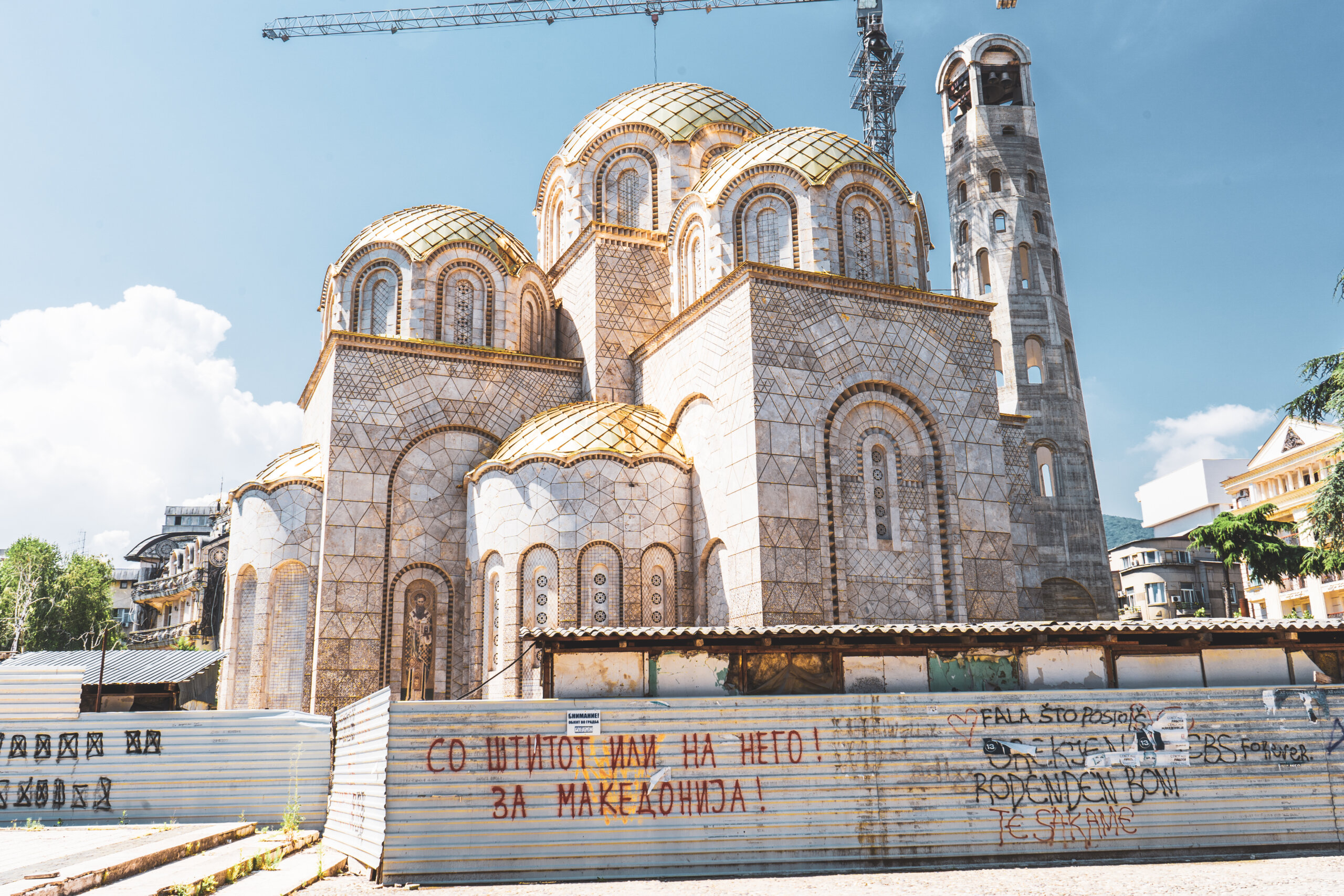
20. Sleep on a pirate ship
Yes, Skopje has a hotel on an old timey ship, because of course it does.
Located in between the Art Bridge and Bridge of Civilizations is Hotel Senigallia, a four-star hotel that’s been built directly in the river to look like a groovy pirate ship that alas, doesn’t actually sail.
Still, this is a very unique place to stay in Skopje and it’s ideally located for seeing many of the sights. Even though it’s not technically a real boat it has been built to look like one, so all the interiors make it feel like you’re on a ship, with slanted wooden walls, chairs built into the walls and lots of ‘seafaring’-type furnishings.
There’s also a restaurant on-board which gets good reviews. Honestly I’m kinda bummed I didn’t stay here while in Skopje, so I might need to return just to live out my pirate fantasies one day!
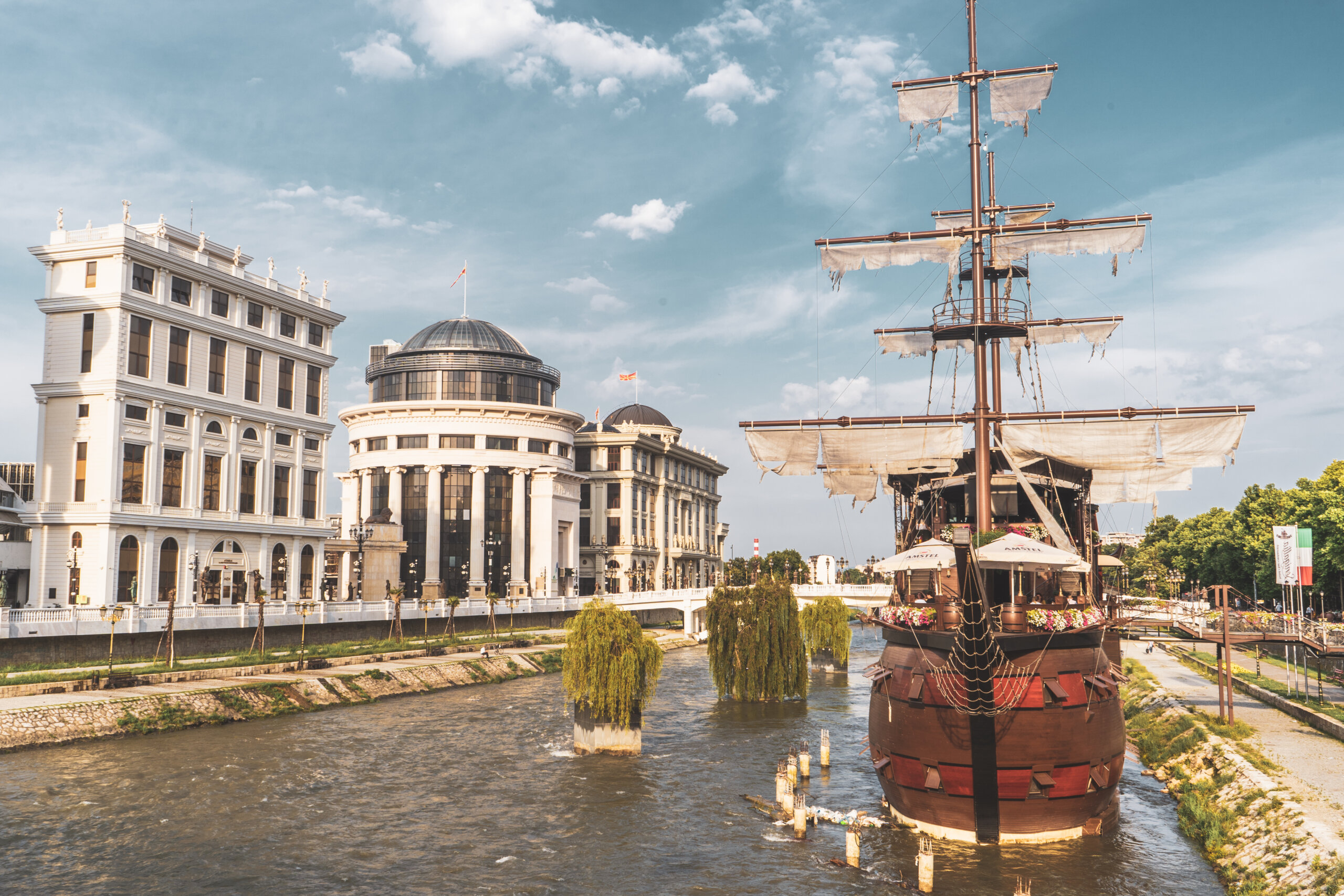
21. Skopje Aqueduct
A little way out of the main city is another surprising sight, an ancient stone aqueduct that spans more than 1,000 feet (390 meters), with 55 arches… and nobody knows who built it!
This is the only aqueduct in North Macedonia and it’s located kind of in the middle of nowhere, with just a dirt path leading to it. It’s not an attraction that’s been maintained or that you need to pay to see, although getting there is pretty difficult if you don’t have access to a car. But if you’re into ancient architecture and architectural mysteries then you might want to make the journey.
There are three theories of who built the aqueduct, and when, but there apparently isn’t enough archaeological evidence for scholars to decide for sure. It was either built during the Roman era around the 1st century, during the reign of Emperor Justinian I (the Byzantine era in the 6th century) or during the Ottoman Empire in the 16th century.
That’s not much to go on but if you like truly off-the-beaten-path attractions then it would at least make for a cool photo spot.
22. Day Trip Out to Matka Canyon
Looking for a beautiful day trip from Skopje? Matka Canyon is honestly one of the most beautiful places I’ve been in the Balkans, and I can’t recommend a trip there enough.
Covering about 5,000 hectares, the canyon is home to the Treska River, which carves through steep cliffs and lush greenery. The area is significant not only for its natural beauty but also for its cultural heritage, with ancient monasteries and caves dotting the landscape.
Visitors to Matka Canyon can enjoy a variety of activities, such as hiking along scenic trails, kayaking on the river, or exploring the Vrelo Cave—a deep underwater cave system that’s believed to be one of the deepest in Europe, if not the world!
Make sure you catch a boat ride, and spend some time enjoying a coffee or lunch on-site. If you don’t have access to a car then you can also book a tour from Skopje.
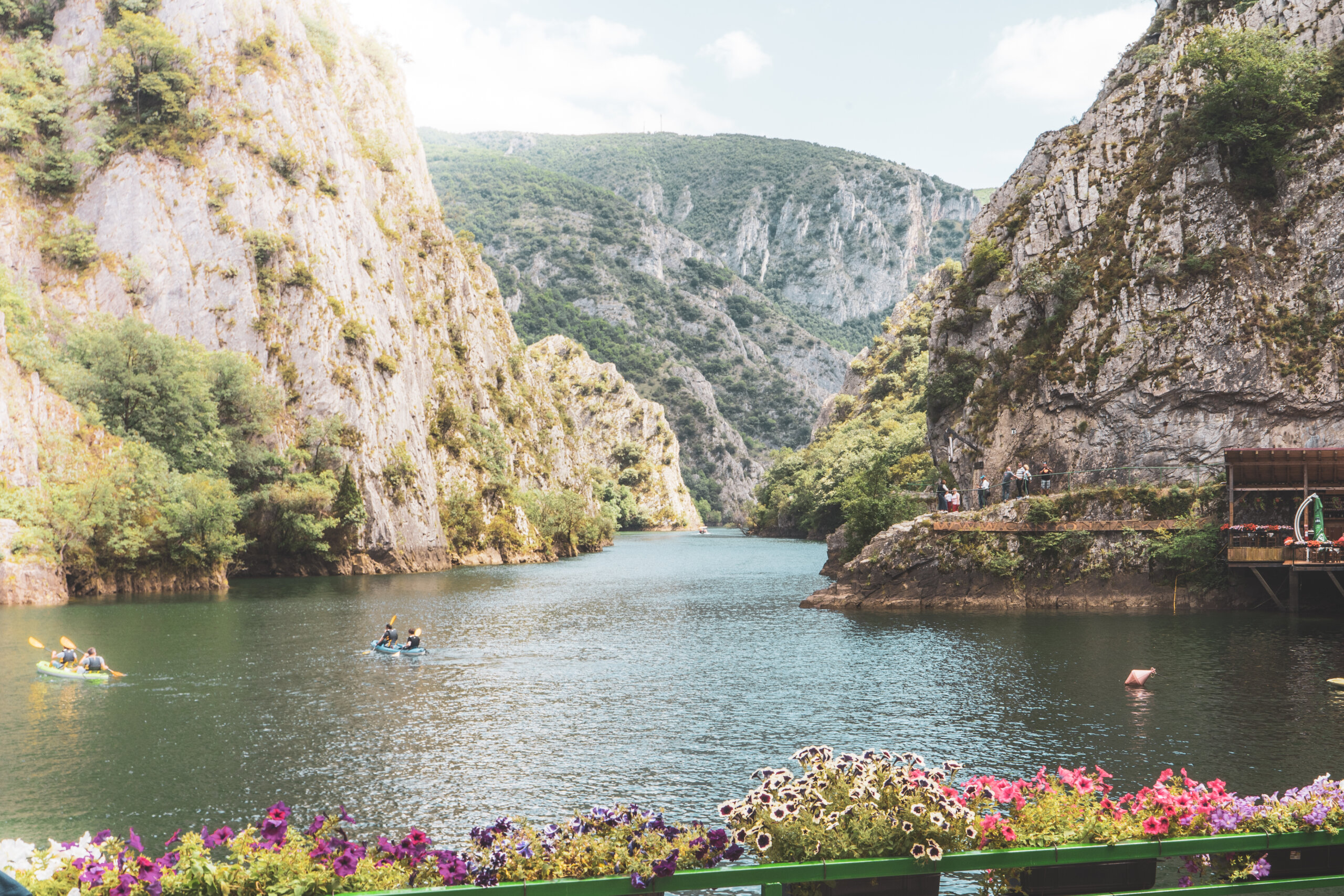
23. Venture onwards in the region
Finally, if you have time, make sure you continue your explorations with some unique destinations that are easily reachable from Skopje, like…
- Mavrovo National Park: For more natural attractions you might like to visit the largest National Park in North Macedonia: Mavrovo. This is a beautiful area with traditional mountain villages to explore and Bigorski Monastery, which is also the biggest monastery in the country. Book a day trip here.
- Lake Ohrid: Another gorgeous spot is Lake Ohrid and the town of Ohrid, both of which are part of the only UNESCO World Heritage Site in North Macedonia. Book a day trip here.
- Berovo and the Maleševo Mountains: If you want to spend some time hiking in one of the most stunning regions of the country, then head to Macedonia’s “little Switzerland” with its water springs and beautiful scenery. Book a day trip here.
- Kosovo: Kosovo is another great country to visit and it’s only a hop over the border from Skopje to see exciting cities like Pristina, beautiful monasteries and even a bear sanctuary! Book a day trip here.
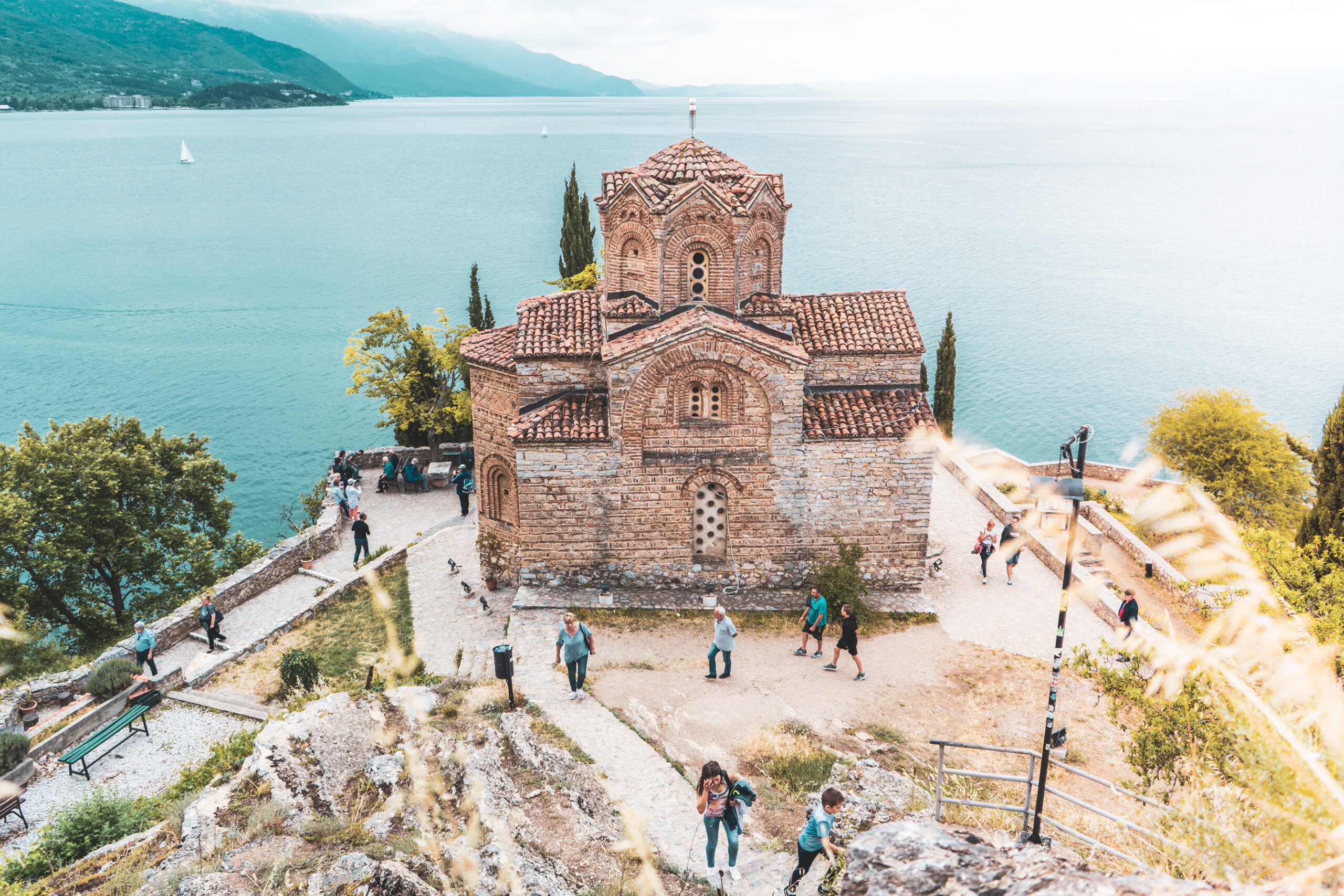
Did I miss any of your favourite things to do in Skopje?
Let me know in the comments so I can add more of the best Skopje activities to the list. Happy and safe travels! 🙂


